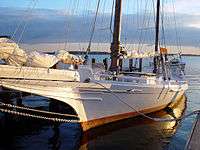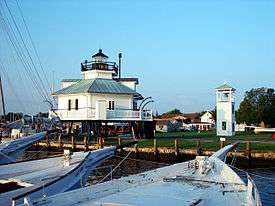Chesapeake Bay Maritime Museum
Coordinates: 38°47′14″N 76°13′13″W / 38.787343°N 76.220229°W
The Chesapeake Bay Maritime Museum is located in St. Michaels, Maryland, United States and is home to a collection of Chesapeake Bay artifacts, exhibitions, and vessels. This 18-acre (73,000 m2) interactive museum was founded in 1965 on Navy Point, once a site of seafood packing houses, docks, and work boats. Today, the Museum houses the world's largest collection of Chesapeake Bay boats and provides interactive exhibits in and around the 35 buildings which dot the campus. The Museum also offers year-round educational seminars and workshops.
Exhibits

The Chesapeake Bay Maritime Museum tells the geological, economic, and social stories of the Bay and those that lived there. Museum visitors can view over 100 boats and boat models, various artworks including a vast collection of watercolors, decoys, guns, ship’s signboards, and other historical Bay artifacts. Larger structures include Tilghman Island’s original Knapps Narrows drawbridge and the 1879 Hooper Strait Chesapeake screw-pile lighthouse. At the Museum’s working boatyard, visitors can have their hand at constructing a wooden skiff through the Apprentice for a Day program (see below). One of the interactive exhibits the Museum offers is Waterman's Wharf, where one can practice seafood harvesting by hauling an eel or crab pot out of the waters of Fog Cove. Another exhibit, Oystering on the Chesapeake, transports visitors to the deck of a working waterman, and explains how the oyster industry has shaped the region’s landscape, culture, and history.
The Floating Fleet is one of the most popular exhibits offered. This collection of water vessels docked at Navy Point includes Edna E. Lockwood, a National Historic Landmark, and the last sailing log-bottom bugeye. The museum helps keep the Chesapeake Bay log canoe racing tradition alive through preserving and sailing the Edmee S., the museum’s own log racing canoe, which is crewed and raced by Museum staff on weekends in the summer. The dredgeboat Old Point, built from seven logs in 1909, was once used to haul fresh fish in the winter, carry oysters during the fall, and dredge clams during the summer. Today, it offers kids a hands on and onboard "waterman" experience. Mister Jim, the museum’s replica buyboat, takes museum visitors out on the water for tours of the Bay throughout summer weekends. Through the variety of exhibits, the Museum provides the opportunity for all to experience the history and culture of the Chesapeake Bay region.
Education and outreach
A community sailing program is offered to teach the basics of sailing. The Lighthouse Overnight Program allows children to experience the life of a mariner standing watch overnight. The Museum also provides programs for children such as Kids Club, as well as hands-on games, crafts, and storytelling throughout the year. For adults, the Museum's programs include a Lecture Series, Adult-Guided Tours, and the Academy for Lifelong Learning, a series of courses centered on continuing learning inside the classroom and beyond. In addition to a variety of programs, the Museum offers a 10,800-volume library of ship plans, manuscripts, books, and sketches.
Working boatyard
The Museum has a working boatyard for restoration projects and education. Visitors can learn about the restoration of commercial skipjacks and the preservation of the Museum's own floating fleet. The "Apprentice for a Day" program allows visitors to help construct a wooden skiff under the guidance of boatyard staff members.
See also
References
- Webster, Philip (2003). Chesapeake Bay Maritime Museum. Virginia Beach, Va.: Donning Co. ISBN 1578642175.
External links
| Wikimedia Commons has media related to Chesapeake Bay Maritime Museum. |
- Official website
- Campus Map
- National Maritime Historical Society
- Historic American Engineering Record (HAER) No. MD-108, "Tilghman Island Bridge, Spanning Knapp's Narrows, Tilghman, Talbot County, MD", 4 photos, 3 data pages, 1 photo caption page
- HAER No. MD-77, "Two-Sail Bateau E. C. COLLIER, Chesapeake Bay Maritime Museum, Saint Michaels, Talbot County, MD", 53 photos, 8 measured drawings, 18 data pages, 3 photo caption pages
- HAER No. MD-171, "Skipjack Caleb Jones, Chesapeake Bay Maritime Museum, Saint Michaels, Talbot County, MD", 5 photos, 3 measured drawings, 1 photo caption page
- HAER No. MD-182, "Tug DELAWARE, Chesapeake Bay Maritime Museum, Saint Michaels, Talbot County, MD", 3 photos, 2 measured drawings, 1 photo caption page
